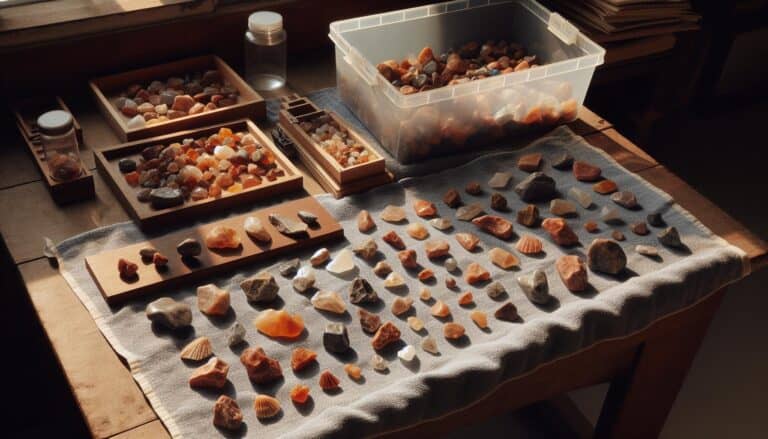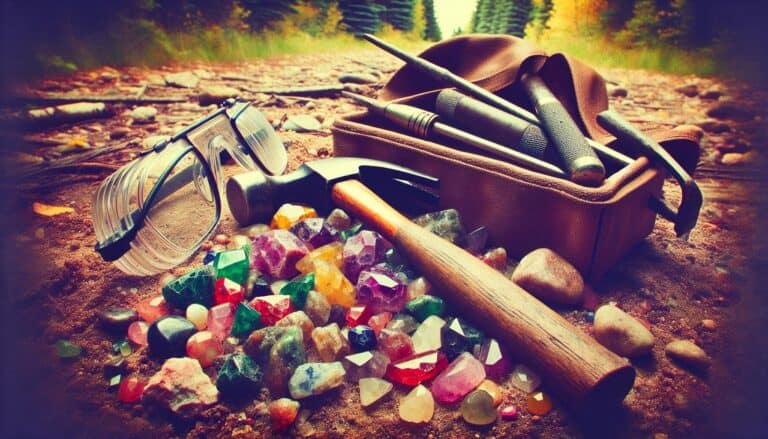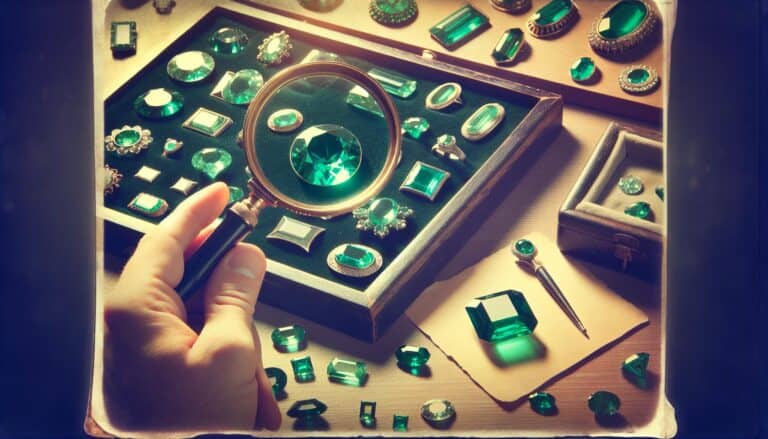Delaware may be one of the smaller states, but it’s packed with hidden gems for rockhounding enthusiasts like you.
From the sandy shores to the dense woodlands, the First State offers a unique array of minerals and fossils just waiting to be discovered.
In Delaware, rockhounds can explore locations like Slaughter Beach for quartz and fossils, and the Piedmont region for minerals like magnetite and garnet. The Brandywine Creek offers quartz crystals, while organized trips with local clubs provide structured experiences. Always check property rights and local regulations before exploring.
Delaware Rockhounding Locations
When you’re looking to delve into Delaware’s treasure trove of minerals and fossils, knowing where to start is key. Delaware’s diverse geology has earmarked several areas that are well-known to rockhounds. Here are some prime locations where you can indulge in your passion for rockhounding and what you might expect to find there.
Slaughter Beach, aptly named for the horseshoe crabs that come to shore to spawn, is a haven for quartz and the occasional fossilized shark tooth. The best time to explore is after a storm when the surf churns up hidden gems from the depths.
Venturing into the dense woodlands of the Piedmont region, rockhounders are likely to stumble upon minerals such as magnetite and garnet. Begin your search near old mine locations where these minerals were once extracted; they often lead to successful finds.
The streams and riverbanks in Northern Delaware are particularly cache-rich zones. The Brandywine Creek, among other sites, yields a good amount of quartz crystals and occasionally mica flakes that shimmer enticingly when struck by the sun’s rays.
For those who prefer a structured approach, organized field trips with local gem and mineral clubs can be an invaluable experience. Not only does it give you access to restricted locales, but also a chance to learn from seasoned rockhounds.
If it’s fossils you’re after, the Chesapeake and Delaware Canal cuts may be the spot for you. The canals expose layers of earth where you can discover marine fossils, including shells and even trilobites that once roamed the ancient sea floor.
Don’t forget to familiarize yourself with the land ownership and collecting regulations of each location. Operating within the legal boundaries ensures that these rockhounding sites remain accessible for everyone. Armed with the right tools and permissions, your Delaware rockhounding adventure awaits.
What Gemstones are Found in Delaware?

Delaware may be a small state, but it’s a treasure trove for rockhounds searching for gemstones and minerals. You’re likely to come across an array of fascinating finds that make every trip worthwhile.
Quartz is one of the most common minerals you’ll encounter in Delaware. This versatile mineral can be found in various forms, including clear rock crystal, smoky quartz, and milky quartz. You could stumble upon these gem-quality quartz pieces around the Piedmont region, which is famous for its geological diversity.
Aside from quartz, the First State is also home to delightful garnets. These deep red stones are a favorite among collectors and can be primarily found in northern Delaware. They’re known for their beauty and are often sought after for jewelry-making. You might be surprised by the quality of garnets that can be unearthed in local streams and cuttings.
For those into more unusual minerals, magnetite is a magnetic mineral that can add an unexpected twist to your collection. While not as visually striking as quartz or garnet, magnetite has its own appeal, especially for educational purposes or magnetic experiments.
Moreover, Delaware beaches deliver a unique rockhounding experience with the prospect of finding shark teeth and marine fossils. Slaughter Beach, in particular, is a hotspot for such discoveries, especially after a storm when the ocean has churned up new material from the depths.
Take advantage of the local gem and mineral clubs for organized field trips. They offer guided excursions that can enrich your rockhounding venture with expert insights and access to less known or private locations.
Before embarking on your quest, make sure your rockhounding gear is ready. A sturdy pair of gloves, a hammer, and a chisel are essential tools to extract samples without damaging them. Remember to pack a bottle of water, too, as hydration is key while you hunt for Delaware’s hidden gems.
What Sedimentary Rocks You Can Find in Delaware?

When scouring the Delaware landscape for impressive specimens, you’re likely to come across various types of sedimentary rocks. These rocks tell a remarkable story of Delaware’s past environments and are a testament to the geological processes that have shaped the region.
Delaware’s northern regions are particularly notable for their historical rock formations. Here, you can find layers of sedimentary rock that were deposited during different geological periods. These include:
- Siltstone: Formed from ancient river deposits, this fine-grained rock is prevalent in Northern Delaware. It’s composed of minerals like quartz and feldspar and can sometimes reveal subtle layering from its formation in slow-moving waters.
- Sandstone: This rock commonly consists of sand-sized mineral particles or rock fragments. In Delaware, look for variations of sandstone with different mineral compositions and colors, each providing clues about the environment of deposition.
In addition to these, the state boasts a range of notable sedimentary rocks:
- Shale: This fissile rock is made up of mud—a mixture of clay minerals and tiny fragments of other minerals such as quartz and calcite.
- Limestone: Formed primarily from skeletal fragments of marine organisms, limestone can be encountered along the Chesapeake and Delaware Canal.
Be mindful that these rock types aren’t just academic curiosities; they’re often homes to fossils that illustrate Delaware’s prehistoric life. The limestone, in particular, can contain a treasure trove of marine fossils, giving you a glimpse of ancient sea creatures that once inhabited the area.
Identifying these rocks can enhance your rockhounding experience, but it requires practice and patience. Invest in a decent field guide to sedimentary rocks, which will help you distinguish between the subtle differences and understand their historical significance. And remember, while these rocky treasures are abundant, always heed local guidelines to ensure that your collecting is permissible and respectful of the land.
What Metamorphic Rocks are found in Delaware?
Delaware might not be the first place you’d think to find a variety of metamorphic rocks, but don’t be too quick to judge. Hidden amid the state’s geologic treasures are some unique and intriguing specimens that you might stumble upon while exploring.
Schist and gneiss are the primary metamorphic rocks present in the Piedmont region of Delaware. You’re most likely to encounter them in the northern parts of the state, where the complex geological history has favored their formation. Rich with layers of different minerals, these rocks offer a glimpse into the immense pressures and temperatures that shaped them millions of years ago.
While scoping out potential rockhounding sites for these metamorphic beauties, pay attention to the areas where you’ve already found sedimentary counterparts. It’s common for schist, particularly, to be near sources of quartz and garnet, hinting at the region’s dynamic geological activity. Look out for the characteristic foliated texture—that’s a giveaway that you’ve found a piece of schist or gneiss.
Remember to gear up with a sturdy hammer and chisel when you search for these rocks, as you’ll need to carefully extract samples without damaging them. And it’s always a good idea to have a field guide handy to help identify your finds.
Exploring the less traveled paths in the Piedmont can lead to surprising discoveries. Occasionally, you might even find evidence of minerals such as staurolite or kyanite embedded within the schist, making your rockhounding trip a veritable treasure hunt.
Don’t forget to review the Code of Ethics for rockhounding before you head out; ensure you’re collecting responsibly and preserving the integrity of the sites for future enthusiasts. Keeping a record of your finds with photos and notes can be just as rewarding as the physical specimens, allowing you to reflect on the experience and plan your next rockhounding adventure.
What Igneous Rocks can You Find in Delaware?
Delaware may not be the first place that comes to mind when you think of igneous rocks, but the First State does have its fair share of igneous formations. Igneous rocks, formed from the cooling and solidification of magma or lava, are mainly found in the northern parts of Delaware, particularly within the Piedmont region.
When you’re in this area, keep your eyes peeled for Diabase, a type of igneous rock that is relatively prevalent in Delaware. Diabase typically forms in small but noticeable bodies and is known for its fine-grained texture. It’s often a dark, greenish-grey stone that can sometimes be confused with basalt.
In your exploration, you may come across pegmatite, an exceptionally coarse-grained intrusive igneous rock with parts of it laced with large crystals. The Pegmatite bodies can house a variety of minerals, including sizable feldspar, quartz, and even rare gemstones like beryl or tourmaline.
- Key ignition points for finding igneous rocks in Delaware:
- Small outcrops in wooded areas
- Creek beds and drainage ditches
- Construction sites with deep excavations
These sites can offer you a glimpse into the fiery past of Delaware’s underground. When searching, you should carry a geologist’s hammer and wear safety glasses. The extraction process for igneous rocks can be tough due to their hardened nature.
Remember that each rock tells a story, and the igneous rocks of Delaware are no exception. They reveal a history of intense geological activity that has shaped the landscape millions of years ago. Keep a field guide close to identify your finds accurately and always respect property boundaries during your search. The adventure and discovery in rockhounding depend on the respect and care you show for the land and its natural resources.
Panning for Gold in Delaware
While Delaware isn’t renowned for its large deposits of gold like some Western states, there’s still a prospect of finding some glimmers of this precious metal if you know where to look. Gold panning in Delaware is more about the thrill of the hunt rather than striking it rich. The areas where you may uncover gold flakes and nuggets are often the same places known for other mineral finds.
Streams and creeks in the Piedmont region are the best bet for enthusiasts aiming to pan for gold in Delaware. Focus on regions where heavier sediments are likely to settle, such as the inside bends of streams, around large rocks, or at the base of waterfalls. These sediments often trap gold particles due to their weight, making them prime spots for panning.
Before you start, ensure you’ve got the right equipment. You’ll need:
- A gold pan
- A sluice box (optional for serious prospectors)
- A snuffer bottle
- A classifier or mesh screen
Remember, patience is key when sifting through materials to find those elusive specks of gold. Swirl the pan slowly to allow the gold to settle at the bottom, separated from lighter materials.
Regarding the legalities, ensure you’re not trespassing and you have permission if you’re panning on private land. Also, be mindful of the environmental impact of your activities—practice eco-friendly gold panning by not digging into river banks and always refilling holes.
To improve your chances, research and network with local prospecting groups. These communities often share valuable insights on promising locations and techniques. You might even find organized outings that’ll let you get your feet wet in gold panning with the guidance of experienced prospectors.
Armed with your pan, a keen eye, and a bit of persistence, you might just add a golden chapter to your Delaware rockhounding adventure. And while the state may not be a gold-rush destination, it could yield just enough sparkle to make your rockhounding excursion a memorable one.
Rocks and Minerals Found in Delaware
Delaware’s geological diversity offers rockhounds a variety of minerals and rocks that are not just fascinating but also quite valuable to collectors. Throughout the state, from the rolling hills of the Piedmont to the sandy shores of Slaughter Beach, you’re likely to encounter specimens that both novice and experienced collectors yearn to find.
You might be intrigued to learn that Delaware is home to a host of sedimentary rocks, which include siltstone, sandstone, shale, and limestone. These rocks often harbor fossils, markers of Delaware’s ancient environments and its prehistoric life forms. Shale and limestone, in particular, are palimpsests of the ocean’s history, often hiding brachiopods, trilobites, and other marine fossils.
In addition to sedimentary rocks, Delaware boasts notable deposits of metamorphic rocks such as schist and gneiss, particularly prominent in the Piedmont region. Known for their beautiful banding and textures, these rocks can reveal a lot about the geological transformations that have occurred over millions of years. When looking for schist and gneiss, target areas close to quartz and garnet locations where the high-grade metamorphism is present.
Venture into the northern parts of Delaware, and you’ll embrace the chance to discover igneous rocks—diabase and pegmatite are local highlights. These rocks have crystallized from molten material beneath the Earth’s surface, and your best bet is to scout them in the Piedmont region. They’re often located in proximity to other quartz and garnet deposits.
As you delve into the world of rockhounding, keep in mind the essentials: always have a field guide to help with identification, use the appropriate rockhounding tools, and most importantly, respect the Code of Ethics for rockhounding. Practice safe and responsible collection techniques — ensuring the sites you visit remain undisturbed for future enthusiasts to enjoy the thrill of discovery.
Where Can I Find Fossils in Delaware?
Delaware’s geological layers are a treasure trove for fossil enthusiasts. Slaughter Beach stands out as a hotspot where the famous “Delaware Diamonds,” better known as quartz crystals, often accompany marine fossils. Here you’ll find remnants of ancient sea life that prospered in the area millions of years ago.
In the Piedmont region, especially near the Chesapeake and Delaware Canal, the sedimentary rocks such as siltstone and shale hold histories of prehistoric organisms. While hunting for garnet and quartz, keep your eyes peeled for imprints of creatures that once roamed the primitive seas.
Northern Delaware often rewards rockhounds with finds of plant fossils and corals, particularly in areas where shale is abundant. Look in cuttings and exposed rock layers where these prehistoric pieces may have surfaced due to erosion.
Tips for Fossil Hunting in Delaware:
- Visit after a heavy rain when fresh sediment is washed away, revealing hidden fossils.
- Arm yourself with a small trowel and a brush to gently uncover and clean your finds.
- Join a local gem and mineral club to gain access to exclusive field trips and locales.
Remember, successful fossil hunting requires patience and respect for landowner rights. Always obtain permission before venturing onto private property or digging in unapproved areas. With the right approach, Delaware can yield impressive fossil finds that illuminate the state’s rich geological past.
Delaware Rockhounding Laws & Regulations
Rockhounding in Delaware offers a wealth of opportunities, but it’s crucial to understand and comply with state laws and regulations. As a rockhound, your actions can impact the environment and the legal accessibility of rockhounding locations for everyone.
First and foremost, you need to recognize that trespassing on private property is illegal without explicit permission from the landowner. Prior to venturing out, research public lands and make sure you’re not infringing on private land. Public areas such as state parks have their own set of rules, and rockhounding may be restricted or prohibited in certain places.
When planning a visit to state parks for rockhounding, remember:
- Some parks require a fee or a permit to collect rocks or fossils.
- Collection is often limited to personal use only and selling your finds might be prohibited.
- You’re typically not allowed to use heavy equipment or explosives; hand tools only.
- There’s usually a quantity limit on how much material you can take.
Delaware is also home to areas of archaeological significance. It’s important to avoid collecting artifacts or anything that could be considered an archaeological object. These items have historical value and are protected under state laws.
For beach rockhounding, like at Slaughter Beach, be aware of the Marine Mammal Protection Act and the Migratory Bird Treaty Act, since some areas might be habitats for protected species. Stay informed about any environmental protections that may relate to your targeted locale.
Most importantly, always practice the leave no trace principles to minimize your environmental impact. This means packing out what you pack in, staying on established trails, and leaving the site as you found it..LinearLayout
By being mindful of Delaware’s laws and regulations, you’ll ensure that rockhounding remains a rewarding and sustainable hobby for years to come. Don’t forget to check for any recent changes in laws or regulations before you set out. Staying on the right side of the law isn’t just good practice; it’s a cornerstone of the rockhounding community’s code of conduct.
Rockhounding Tips for Beginners in Delaware
Gearing Up: Essential Tools for Rockhounding
Starting your rockhounding adventure means equipping yourself with the right tools. Essential gear includes:
- Rock hammer: This is your primary tool for breaking and splitting rocks.
- Chisels: To help pry rocks from their matrix and to split them cleanly.
- Safety glasses: Crucial for protecting your eyes from flying rock chips.
- Gloves: Heavy-duty to safeguard your hands during digging and handling rough rocks.
- Trowel: Useful for digging out softer sediments and for careful excavation around fossils.
- Field guide: Helps with identification of rocks, minerals, and fossils.
- Buckets or Bags: You’ll need something sturdy to carry your finds.
Remember, quality counts. Investing in durable, well-made equipment ensures safety and efficiency.
Safety Tips While Rockhounding
When venturing out for rockhounding, it’s important to prioritize safety:
- Always wear protective gear: That means sturdy boots, safety glasses, and gloves.
- Never rockhound alone. Having a buddy means extra help and safety in case of emergencies.
- Stay aware of your surroundings. Watch for slippery terrain, sharp rocks, and unstable ground.
- Keep a first-aid kit and plenty of water with you.
- Inform someone about your location and expected return time.
Adhering to these tips not only protects you but also makes your rockhounding excursion more enjoyable.
Legal Guidelines for Rockhounding Enthusiasts
Being aware of legalities ensures a hassle-free experience:
- Understand that not all land is open for collecting. Always secure permission from landowners or authorities.
- National and State Parks often have strict regulations. Collecting may be prohibited or restricted to certain materials and amounts.
- Practice “Leave No Trace” principles. Fill any holes you dig and take your trash with you.
- Avoid collecting in archaeological or historical sites. It’s illegal and unethical.
- Stay updated on laws. Regulations can change, so it’s important to stay informed.
By following these guidelines, you help preserve rockhounding areas for everyone’s future enjoyment.
Conclusion: Delaware Rockhounding Map
Delaware offers a treasure trove of geological wonders for you to explore.
From the fossil-rich sedimentary layers of Slaughter Beach to the sparkling quartz and garnet of the Piedmont region, your rockhounding adventure awaits. Remember to arm yourself with the right tools and knowledge—safety gear and a field guide are must-haves. And while you’re immersing yourself in the thrill of the hunt, always stay respectful of the land and its rules. Keep up-to-date with any changes in regulations and be a conscientious member of the rockhounding community. With these tips in mind, you’re set to uncover the hidden gems of Delaware’s diverse landscape.
Happy rockhounding!







